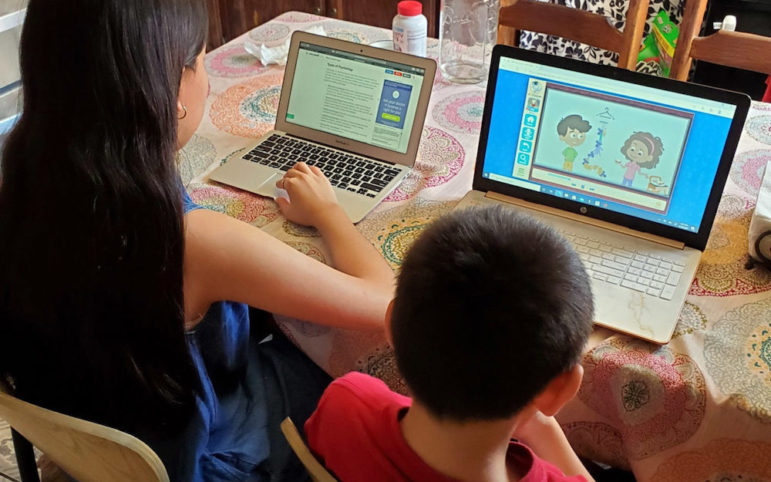Recently released test scores from some of California’s largest school districts — representing more than 1 million students — offer a preview of what’s likely to be steep drops in reading and math scores statewide in the wake of COVID.
The scores, which districts released individually at the request of EdSource, show sharp declines in all grade levels from 2019, before COVID forced the closure of most campuses to in-person learning, and 2022.
The California Department of Education has delayed releasing the full statewide results from the 2022 Smarter Balanced assessments, which are given annually to third-through-eighth graders and 11th graders to measure progress in English language arts and math.
Under pressure from EdSource and other media outlets, the department recently agreed to release the scores by the end of October.
Meanwhile, EdSource has collected individual results from 10 large districts, including Los Angeles Unified, San Diego Unified, Fresno Unified, Lodi Unified, Long Beach Unified, Sacramento City Unified, Sweetwater Union High School District, San Ramon Valley Unified, Bakersfield City School District and Mt. Diablo Unified.
The results show consistent declines in all categories from 2019, but some variations among districts and subgroups:
- Only 13% of students in Bakersfield met the state standard for math.
- Reading scores in Los Angeles Unified only dipped slightly from 2019 to 2022. Still, only 41% of students in 2022 were proficient in reading.
- Math scores in Fresno dropped by a third. In 2022, only 21% of students met the math standard.
- Reading scores in Long Beach dropped 11 points, but declines were less steep in math. Math scores fell only 4 points.
- In Mt. Diablo Unified, one of the few districts to break down the results by subgroup, Black, Latino, English learner, foster and homeless students had far lower scores compared with 2019 than their white and Asian peers. For example, among English learners, 96% did not meet the math or reading standards.
By and large, scores show little change from 2021, the first results after the state suspended the 2020 tests due to COVID. The 2021 test was optional for schools to administer, so results were limited and likely not an accurate reflection of students’ progress overall. Just under 25% of students took the test in 2021.
Lodi Unified saw scores in both math and reading improve from 2021, but they still lag significantly from 2019. That’s not a surprise, considering the difficulties teachers and students faced as they returned from distance learning, said Robert Sahli, assistant superintendent.
“Last year, even though we were back in person, it was very challenging,” he said. “Teachers and support staff were working very hard to address learning loss while also responding to the social-emotional impacts on learning and socializing at school.”
Like other districts, Lodi has hired more tutors and teachers to help students catch up, beefed up summer school and after-school academic offerings, adopted new curricula and taken other steps to bring students to proficiency.
Heather Hough, director of Policy Analysis for California Education, said the preliminary results are actually better than she expected. Because 2022 is the first year all schools were required to give the test, she anticipated a significant drop from 2021.
“We thought 2022 would be a recovery year, but there was so much chaos — teacher shortages, students missing school — that it turned out to be another pandemic year,” she said. “If the scores are the same (as 2021), that’s actually encouraging.”

When the state releases the full data, Hough and her colleagues will pay close attention to differences among subgroups and statistical anomalies. If one district, for example, shows good results for students in special education, it would be worth researching what special steps that district has taken.
She also noted that some students thrived during remote learning, so she expects some good news, as well. In any case, schools and districts, as well as statewide policymakers, should use the scores to shape their allocation of resources in the coming years.
“When we get this data, we’ll finally be able to see how California is doing, what challenges we’re facing, and how we can best help students as we move forward,” she said.
In anticipation of the statewide release of test scores, the state last week launched a push for schools to help students regain skills they lost during COVID. The state is emphasizing accelerated learning, rather than remedial lessons, to speed up the process.
Steps like that could be the most useful result of the Smarter Balanced scores, said Lucrecia Santibañez, associate professor of education at UCLA. Closely analyzing the data and using it to forge a path forward — specifically for certain groups of students — is more useful than assigning blame, she said.
“COVID was tough for everyone, and it’s not worth putting blame on anyone. Everyone was trying the best they could. But these scores signal that we need to make a personalized, intensive effort to help kids catch up and recoup what they’ve lost,” she said.
Although the scores are disappointing, they can be an important tool to help schools pinpoint resources in the future, she said. The scores can provide a window into what exact content students have missed, where they’re lagging and which students need the most help, she said.
At Mt. Diablo Unified, Raymond Tjen-A-Looi, director of assessment, research and evaluation, told the school board that comparisons with 2021 aren’t helpful because education was still so disrupted due to COVID.
“We’re concentrating on using 2022 as a baseline, with the expectation that everything will stay the same going forward — testing will be in person, instruction will be in person,” he said. “So moving forward, hopefully, we’ll be able to do more comparisons and see how well we are making up for what we’ve lost.”

COVID did not close schools. Adults chose to close schools. They were not forced; it was a choice